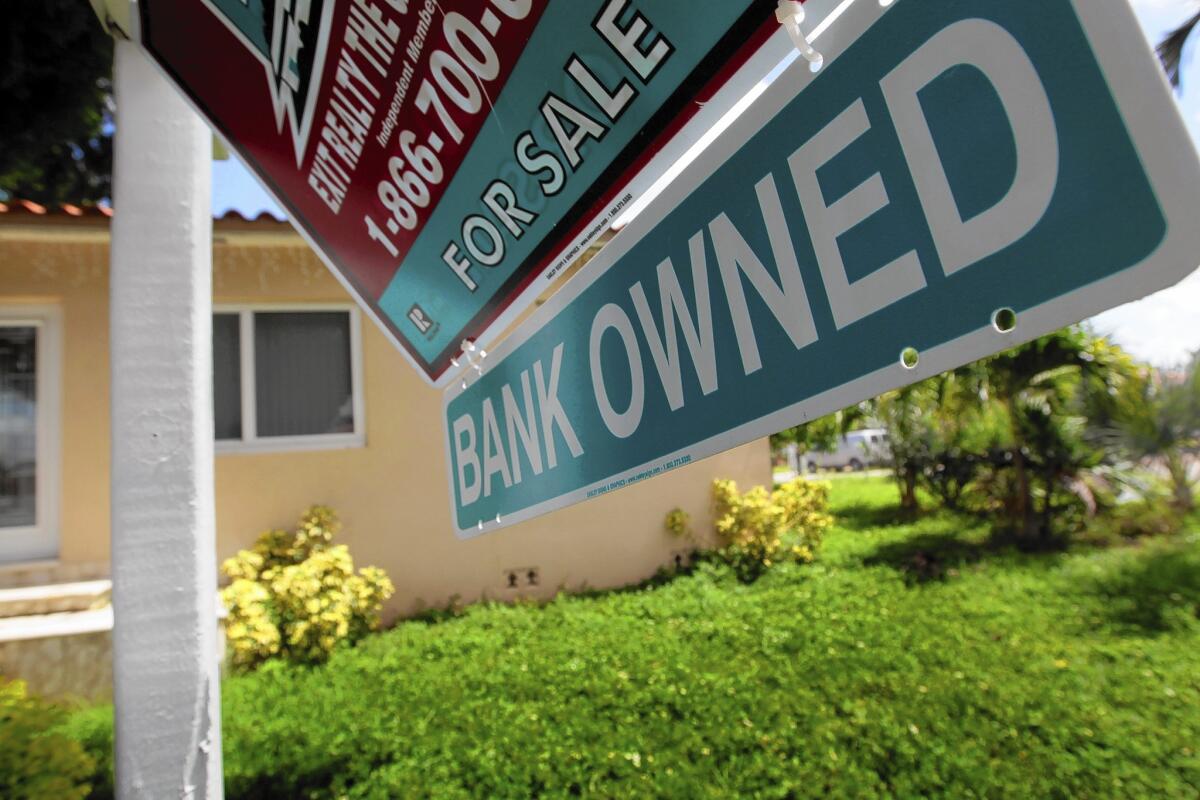Many homeowners with loan mods face rate increases

- Share via
If you are one of the millions of once-desperate homeowners who have had their loans reworked by a mortgage company to avoid foreclosure, it’s time to start facing the possibility of having to do it all over again.
Beginning this year, those whose loan terms were modified so that the interest rate dropped to as low as 2% will have to deal with higher rates that could, in some cases, drive the monthly payment as much as $1,724 higher.
Why? Because “permanent” interest rate reductions under the government’s Home Affordable Modification Program were anything but. Whether participants realize it or not, rate reductions last for only five years. Consequently, the clock is ticking — especially for the earliest beneficiaries of the program, which was built to help underwater or financially strapped borrowers save their homes.
Exactly how many borrowers face higher rates and larger payments is unclear.
As of Dec. 1, 2013, 88% of the nearly 900,000 people who had their loans modified under HAMP were scheduled for increases, according to a report from the special inspector general for the Troubled Asset Relief Program. A report from the Urban Institute, a research organization, says that as of January, more than 1.1 million owners received interest rate abatements under the program.
Moreover, countless others received modifications under lenders’ proprietary relief programs that were patterned after HAMP, which was created under the Financial Stability Act of 2009 as a collaboration among lenders, investors, mortgage servicers and Uncle Sam’s housing agencies to create standard loan modification guidelines.
The Urban Institute says the number of proprietary mods is “considerably higher” than the number of HAMP mods — perhaps five times higher, or something above 5 million.
HAMP works like this: Lenders are required to take sequential steps — called a “waterfall” — to cut borrowers’ monthly payments to 31% of their gross monthly incomes. After five years, the rate resets upward by up to 1% a year until it reaches its cap, which is the market rate that was in effect when the loan was modified.
All other terms of the modification — an extended loan term and principal forbearance — are supposed to remain unchanged.
For 2009 and 2010 modifications, the maximum rate is about 5%. So if the market rate was, say, 5% five years ago when your mortgage was reset to 2%, it will go up to 3% this year on the anniversary of the adjustment. It will remain at 3% for the following 12 months, then ratchet up to 4% for 12 months, and then up to 5%.
Market rates declined in 2011 and thereafter, so the total reset won’t be as great for loans modified that year and thereafter. But the increase will still be 1 point a year until the market rate from the time of the modification is reached.
Reviews are mixed about the effect of the pending resets. The Urban Institute, for example, says most borrowers should be able to handle the first two jumps, but the third one “may prove problematical.” Consequently, it argues that there won’t be a big problem until 2016, when the 2009 cohort experiences its third increase in mortgage rates.
The nonprofit, nonpartisan policy research organization also thinks the fears of massive re-defaults are “overblown.” Although defaults in the private sector tend to jump 15% when borrowers are faced with large resets, that “should be regarded as an upper bound,” it says.
Why? For one thing, HAMP resets will be taking place in a healthier housing market, with rising prices giving borrowers a growing equity stake in their homes. For another, perhaps half of HAMP recipients who are in danger of defaulting again should qualify for an alternative modification.
The Treasury Department’s special inspector general for the Troubled Asset Relief Program says only 12% of the borrowers with active HAMP mods are not slated for increases. The rest are in for changes, with some eventually seeing their rates jump to as high as 5.4% and their monthly payments rise by $1,724. Half of all owners with active HAMP modifications reside in just four states: California, Florida, New York and Illinois.
And the number crunchers at Black Knight Financial Services point out that more than 40% of the 2 million borrowers who benefited from modified loan rates still owe more than their houses are worth. Moreover, the data and analytics firm says an additional 18% have 9% equity or less in their homes. (Borrowers with less than a 10% stake in their properties usually must bring cash to the table to pay loan fees and closing costs.)
Under HAMP, loan servicers are required to notify borrowers of a pending rate increase no less than four months in advance. And a second notice is required no later than 60 days before the rate reset.
But borrowers shouldn’t wait for the notice to act. If you have any inkling that a rate increase is coming, be proactive. Start gathering your financial information now.
You’ll need, among other things, the two most recent pay stubs for all household members contributing to the mortgage payments, your last two years’ tax returns, your most recent profit and loss statement if you are self-employed, your two most recent bank statements, account balances and minimum monthly payments due on all credit cards.
It’s also a good idea to get current on your bills if you are not already, and check to make sure the info in your credit record is accurate and up-to-date. Then reach out to your lender to see what options might be available. You might be able to refinance, or you may be in line for another loan modification.
Distributed by Universal Uclick for United Feature Syndicate.
More to Read
Sign up for Essential California
The most important California stories and recommendations in your inbox every morning.
You may occasionally receive promotional content from the Los Angeles Times.






